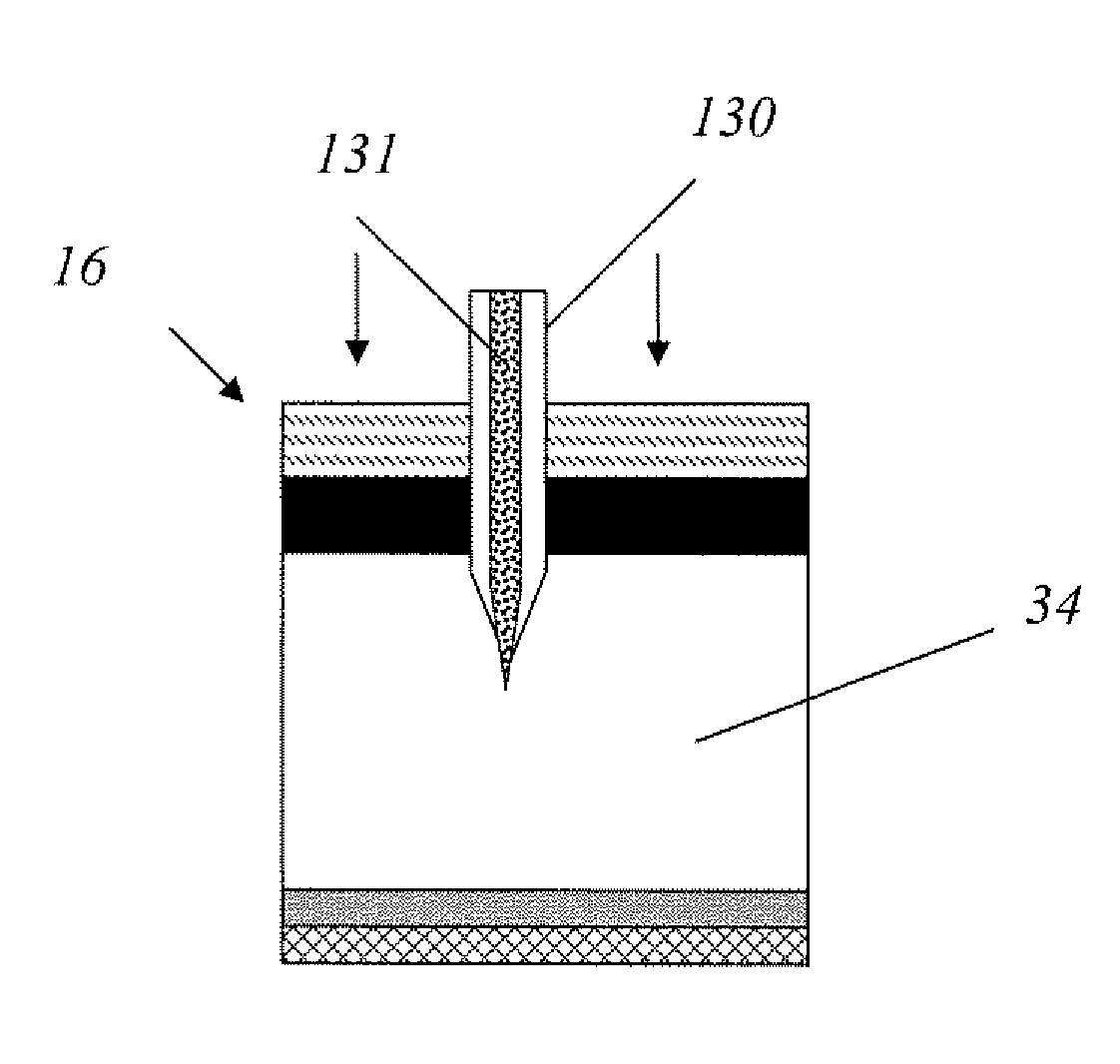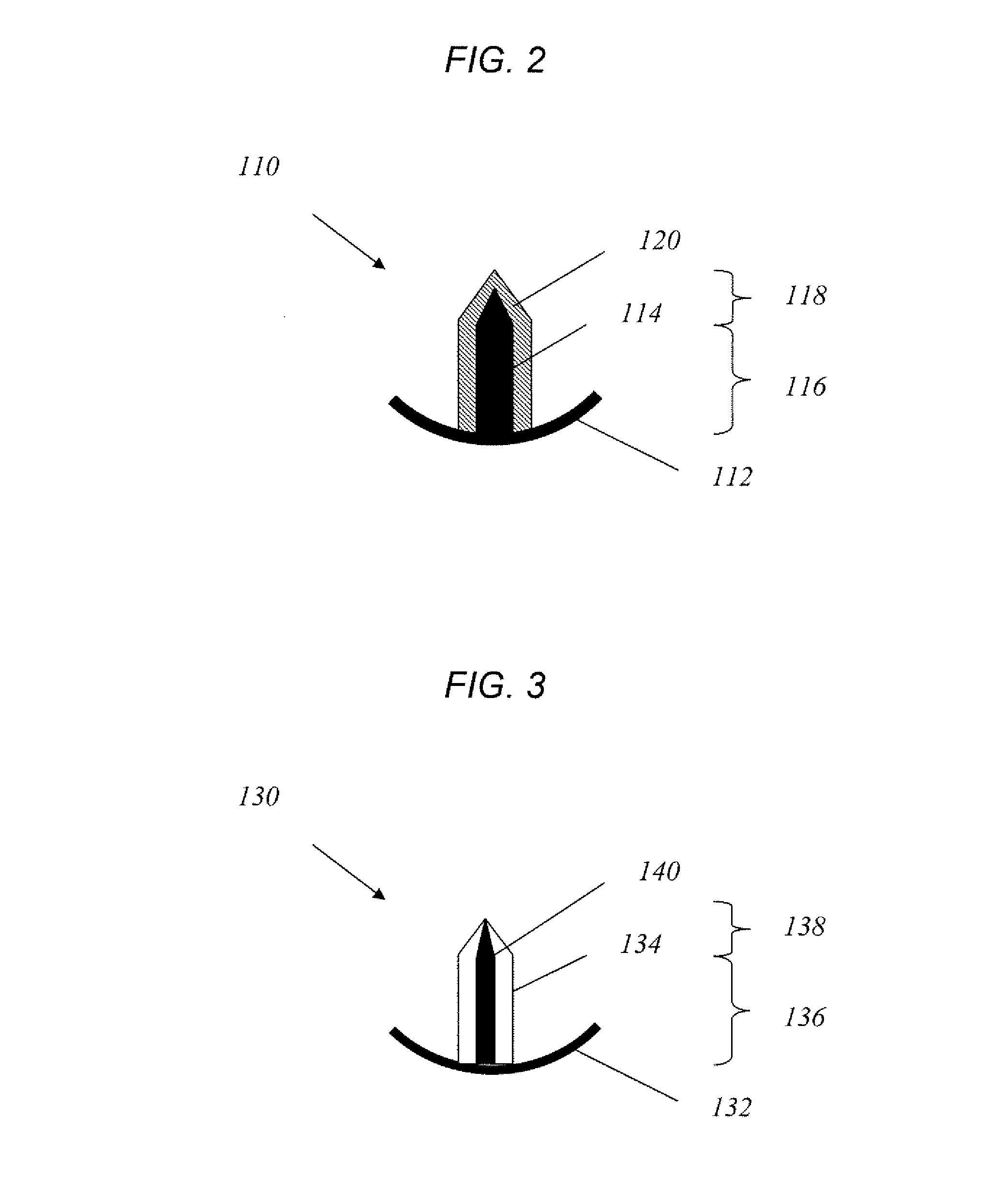Method for drug delivery to ocular tissue using microneedle
a technology of ocular tissue and microneedles, which is applied in the field of ophthalmic therapies, can solve the problems of significant side effects, difficult to deliver effective doses of drugs to the back of the eye, and difficult to deliver drugs to the ey
- Summary
- Abstract
- Description
- Claims
- Application Information
AI Technical Summary
Benefits of technology
Problems solved by technology
Method used
Image
Examples
example 1
Drug-Coated Solid Microneedles
[0079] Single solid microneedles were fabricated using an infrared laser to cut microneedles from 75 micron thick stainless steel sheets. To deburr and sharpen the microneedle edges, electropolishing was done in a 1:3:6 v / v mixture of water:phosphoric acid:glycerine at 70° C. The final microneedle dimensions were 500 μm in length, 50×200 μm in cross section at the base, and 55° in tip angle. For in vivo rabbit experiments, the microneedles were modified to 500 μm in length, 50×100 μm in cross section at the base, and 45° in tip angle, to avoid penetration through the thinner rabbit corneal tissue. To facilitate handling microneedles using forceps during insertion into tissue, an extended metal substrate was attached to the needle base, which measured 1 cm in length, 4 mm in width and 50 μm in thickness, was included in the needle design.
[0080] The microneedles were coated at room temperature using a dip coating method and an aqueous coating solution. ...
example 2
In Vitro Drug Delivery to Human Sclera
[0081] Human sclera was obtained from the Georgia Eye Bank with the approval of the Georgia Tech IRB. Pieces of the scleral tissue were cut to a size of 0.7×0.7 cm using surgical scissors and rinsed with deionized water. Adherent tissues associated with the retina, choroid, and episclera were removed from the scleral tissue with a cotton swab and the scleral tissue was then placed on top of a hemispherical surface (0.6 cm in radius), which simulated the curvature of the ocular surface.
[0082] Uncoated single microneedles from Example 1 were manually inserted approximately half way into the sclera tissue and then removed. The insertion site was stained with a blue tissue dye and imaged by brightfield and fluorescence microscopy to assess the site and extent of delivery.
[0083] The microneedles were found to be sufficiently strong and sharp to penetrate into the sclera without bending or breaking (data not shown). Within two minutes, the micronee...
example 3
In Vivo Drug Delivery to Rabbit Cornea
[0087] New Zealand white rabbits were anesthetized using intramuscular injection of ketamine and xylazine. Then, the fluorescein-coated microneedles from Example 1 were inserted into the upper region of the cornea and left within the tissue for two minutes. After removal of the microneedle, fluorescein concentration in the anterior segment of the eye was measured by spectrofluorometry for ≦24 h (n=4).
[0088] To facilitate imaging and fluorometric analysis, fluorescein was delivered to the cornea, rather than the sclera, and monitored fluorescein concentration in the anterior of the rabbit eye for 24 hours after insertion of a microneedle coated with 280 ng fluorescein. As shown in FIGS. 8A-B, fluorescein concentration was measured over time as a function of the distance along the visual axis in the anterior segment of the eye from the cornea to lens. Prior to microneedle insertion, only small amounts of background fluorescence were detected in ...
PUM
 Login to View More
Login to View More Abstract
Description
Claims
Application Information
 Login to View More
Login to View More - R&D
- Intellectual Property
- Life Sciences
- Materials
- Tech Scout
- Unparalleled Data Quality
- Higher Quality Content
- 60% Fewer Hallucinations
Browse by: Latest US Patents, China's latest patents, Technical Efficacy Thesaurus, Application Domain, Technology Topic, Popular Technical Reports.
© 2025 PatSnap. All rights reserved.Legal|Privacy policy|Modern Slavery Act Transparency Statement|Sitemap|About US| Contact US: help@patsnap.com



